

|
Home Updates Hydros Cars Engines Contacts Links Contact On The Wire ← Previous |
David Giles
Tethered Model Car Racing
After that diversion, back to the main story:
Many tracks were built in the UK in the period 1949 to 1955 including the Bristol and West of England track at Church Lane, Downend, which was "well on the way to completion" in May 1949 according to Model Car News. Racing flourished in most areas of the UK and there were a number of competitions held for prestigious trophies donated by big companies like Castrol, Redex etc. but it would appear that the first National Championships were held in 1950. Development continued rapidly, with the European Championships held in Great Britain at Woodside near Luton in 1954.
From that point in time, there was a gradual but accelerating decline in interest, with the last British participation in an international competition in 1958 (until I came along) and the last recorded race meeting being held at the Blackpool track in 1959.
|
The last British track, at Mote Park, Maidstone, Kent, finally closed in 1970, bringing to an end the running of tether cars in the UK. Right: David Giles and
Dave Cunliffe at Mote Park Pathe video clip of Mote Park with Bill Bennett |
|
|
Moving on from the growth of activities in Western Europe, and the decline in Great Britain, we must now consider the birth of the hobby in the USSR and Eastern Block, as for many years competitors from the USSR dominated the development of cars, engines and fuels and innovative ways to stretch the meaning of the rules.
Some time after the Second World War, the precise date is difficult to ascertain, various large state organizations were set up in the Soviet Union, each responsible for specific activities. This was in complete contrast to the situation in the West, where model engineering in it’s various forms was essentially an amateur activity. The organization covering tether cars was known as D.O.S.A.A.F. and was effectively part of the Soviet Army. It was responsible for the administration of all kinds of technical sports including model aeroplane flying, model boat racing and as already mentioned, tether car racing.
The first Championship of the Soviet Union was held in 1957; unfortunately I do not know the venue or any results. Tether car racing was and still is actively pursued in Russia and a number of the former Soviet satellite countries, although as we now know, they were never really willing participants when competing under the USSR (or CCCP) banner.
There is a further diversion I would like to take you on, vitally important to the ongoing development of tether cars, with a subsequent activity of great significance to the cars of today and how we run them.
Around 1962, a well known American speed flyer, the late Bill Wisneiwski began experimenting with tuned length exhaust systems on his control line aircraft. He had the facilities and the knowledge to do this effectively, as he was Chief Designer for K&B racing engines and had an enviable track record with the K&B Torpedo engines which dominated their various competition classes at that time. After winning the 2.5cc World Speed Championships in 1966 with his then radical engine/pipe combination, he made all his development work on engines and pipes freely available.
|
This enabled a transformation in performance of speed model aeroplanes, tethered hydroplanes and of course tethered cars in a relatively short space of time. Centre:
One piece steel tuned pipe for 10cc motor. |
|
|
With the uptake of tuned pipe technology, it was not long before the technique known as ‘whipping’ in control line model aeroplane flying became the norm in tether car racing. Whipping involves the pilot dragging the model like a slingshot in order to increase the airspeed until the engine can reach a point in the power band such that it can maintain viable flying speed. This technique was brought to perfection for car racing in 1970 by two people from the former Soviet Union; Yuri Lysak and Victor Gerassimov. In tether car racing it is known as ‘horsing’ and without this, the piped engines with their extreme exhaust and induction timing and consequent narrow power bands would not be able to come into resonance. This is a parallel technique to the use of large numbers of gears in racing 2 stroke motorcycles – the Horser is effectively the lower ratios of the gearbox.
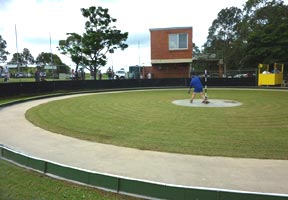 |
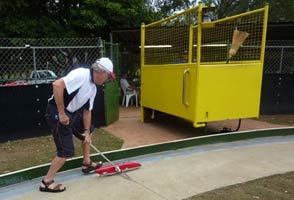 |
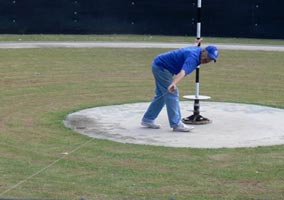 |
| The Sydney track | Push starting | 'Horser' in action |
Horsing soon became the norm and finally sounded the death knell for the traditional open exhaust racing engines exemplified by the Dooling 61 and the Underwood Yellow Jacket, which once settled, would ‘wind up’ to their maximum speed. As a matter of interest, Yuri Lysak, who is from Ukraine and a specialist in electron - beam welding is still active in tether car racing, and produces some of the best pipes for 10cc cars.
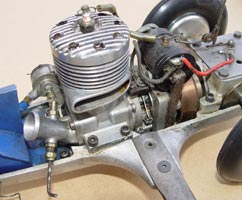 |
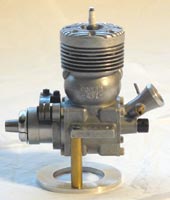 |
|
|
| Dooling 61 |
Underwood Yellow Jacket |
||
As we move into the recent past, and bring the story right up to date, I think it would be a good idea to give some statistics:
Racing continues to thrive in a number of countries in Europe, including Estonia, France, Germany, Hungary, Italy, Lithuania, Poland, Russia, Ukraine, Switzerland and Sweden, with additional participants with no home tracks from Bulgaria, Belorussia, Finland, Great Britain, Latvia, and Norway. It is also alive and well in America and Australia.
The regulation track diameter is 19.9 meters, to the centre of the running surface, giving a radius of 9.95 meters or 32.67 feet. This equates to 8 laps to the half kilometer, the standard timed distance. All timing is done electronically to three places of decimal seconds and most organizers now provide a numerical printout, some even a graphical representation of the whole run.
Cables are made from piano wire and currently (2012) the diameters in use are as follows:-
Class 1: 1.5cc – 0.9 mm Class 2: 2.5cc – 1.2 mm Class 3: 3.5cc – 1.2 mm Class 4: 5.0cc – 1.6 mm Class 5: 10cc – 2.0 mm
Current World Records are as follows:-
Class 1 – 268.697 kph (167.93 mph)
Class 2 – 285.711 kph ( mph) Class 3 296.393 (184.06mph)
Class 3b (European Record) – 273.562 kph
( 169.85mph) Class 4 – 317.124 kph (196.93 mph)
Class 5 – 344.959 kph (215.60 mph)
From the early 1970s onwards there has been steady development in car design, and engine and pipe technology with occasional large jumps in performance. Much of this was led by the competitors from the Soviet Union, who were under the strict control of the state and based in research establishments specifically involved in miniature car and engine development. Also research departments of universities, or precision machining factories involved in small arms manufacture, particularly of trigger mechanisms. Cars and engines became increasingly specialized and gradually narrower until first front wheels, and then rear wheels were enclosed within the body shell. This is a universal design feature of all cars running today with the exception of Class 3, which was formulated some time in the 1980s as a beginner’s class, but is now one of the most difficult classes to compete in, due to its prescriptive rules.
Although the engines dominating racing in the early 1970s were mainly manufactured in the Eastern Block, Italy was producing engines which with some modification, could produce very similar performance. The exception to this was the 1.5cc class, in which the engines produced by Lothar Runkehl in Germany consistently ran very close to the fastest. In fact, Lothar is still running successfully and occasionally supplies engines to selected old friends.
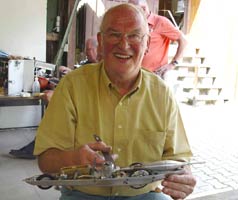 |
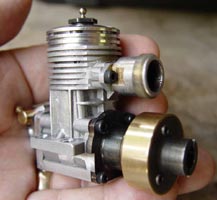 |
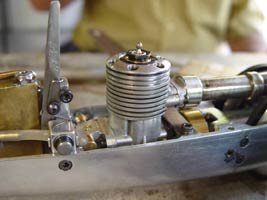 |
|
Lothar Runkehl |
Loru 15 |
Motor installed |
Of the Italian engines, the first specifically designed for tether cars was the early model OPS 60 of 10cc capacity which featured a Zimmermann inlet valve and matching exhaust pipe. Others designed for speed control line aircraft, which could be used with varying amounts of modification were the OPS 29 and Super Tigre 29 in the 5cc class and the Rossi 15 in the 2.5cc class.
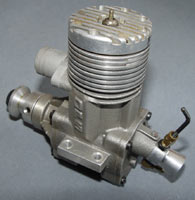 |
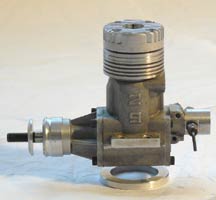 |
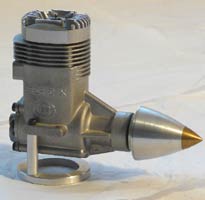 |
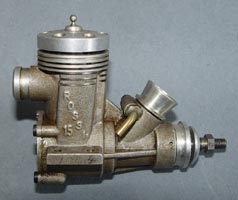 |
| OPS 60 | OPS 29 | Super Tigre 29 | Rossi 15 |
For the 1977 racing season a very important and universal rule change was made, banning really exotic fuels. This was partly due to rocketing costs of nitro methane, but also due to safety considerations, as many people were using additional additives such as nitrobenzene, toluene and tetra-nitro methane. Once again, the Soviet competitors were able to dominate as they had access to fuel ingredients unobtainable in the West, some of which were so lively they would fizz and burn the track surface even if only a small quantity was spilt. The fuel used now consists of 80% Methanol and 20% Castor oil, known as 'straight fuel' and is always supplied by the event organizer, this means nobody has to transport their own, and quality and consistency are assured.
Suspension systems have developed since their introduction in the early 1970s which has enabled much greater speeds to be achieved due to the enhanced stability of the car in the pitching mode.
|
Early systems used coil springs at front and rear, the most common configuration being a gearbox with trunnions at the front end and a pivoted beam type of front suspension. This, although a great improvement, did not solve the problem of damping, so an alternative was developed for the front suspension using a rubber block to provide a simple spring/damper system. Right: David Giles' 1979 Championship winning 5cc car, with a MOPS 29 motor (Malik modified OPS). Car rigged for anti-clockwise running. |
|
The final enhancement to suspension systems came about with the availability of good quality spring damper units designed for ⅛ scale radio controlled cars. These are available in such a variety of sizes that suitable units can be found for every capacity class.
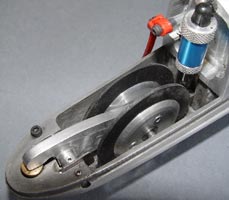 |
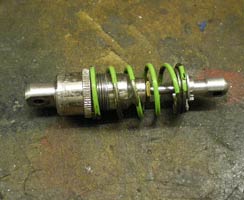 |
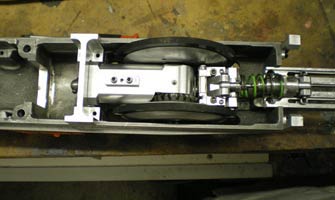 |
| Front suspension | Spring damper unit | Gearbox and rear suspension |
Some time during the early 1980s some Italian enthusiasts tried running their 2.5cc cars in a clockwise direction to improve the fuel feed to their engines. They found a sudden increase of 10-12kph in speed, which could not be easily explained. After a lot of analysis and calculations, it was found that the Gyroscopic Precession of the flywheel caused a downward force on the rear wheels which reduces slipping. This jump in speed applied to all classes as people modified their cars accordingly. Obviously this change does not apply to to Class 3B cars which are of spur gear configuration, and in fact the forces acting are much more complex.
|
Obviously this simple change did not apply to Class 3 cars which are of spur gear configuration. Centre: 3.5cc Novarossi on
spur drive mount |
|
|
One of the most influential individuals of the last forty or so years both as a competitor and manufacturer of engines was the late Gualtiero Picco. Towards the end of the 1960s, along with Sgnr Saoner, he founded OPS (Officine Picco e Saoner) and produced the first of a number of motors that would be used to great effect in tethered cars and hydroplanes, right through to the present day, albeit with considerable amounts of tuning and blue printing. Picco eventually set up his own factory creating racing engines for almost every modelling discipline. His 'P' series, and later the EXR, took over the mantle of success, and have been totally dominant in Class V tethered cars for many years, including numerous World records and World and European championships. The only person to seriously challenge the Picco stranglehold has been Mats Bohlin of Sweden with his own, limited production MB 10 motor.
|
|
|
|
| Gualtiero Picco | Picco P60 | Picco EXR |
Probably the most influential, and unsung, hero of modern tether car racing is Horst Denneler. He has worked tirelessly for the hobby for very many years producing and supplying countless chassis, gearboxes, wheels and tyres, flywheels and gear sets. There can be very few cars running currently in Europe, America or Australia that do not have at least some components originating from Horst in their construction. Many, including my European Championships winning car, are Denneler ‘kits’. He is the only person to my knowledge to have been awarded the Badge of Honour in the form of a gold lapel pin (the German word is Ehrennadel which I think is somewhat more descriptive) in recognition of his services to the hobby. His latest project is a 2.5cc engine, currently available, and showing every sign of being very successful in the right hands.
|
|
|
|
| 2.5cc motor | 10cc Class 5 car | Horst Denneler |
Since the fall of the Berlin wall and the collapse of the Soviet Union, there has been a transformation of the hobby, as people who could only meet at the European Championships and only communicate when out of earshot of the 'Sport Commissars' can now travel freely and communicate by telephone and email.
However…
This is not to say that contact never happened – there are some wonderful stories of bartering and exchanges of cars, components and equipment during the cold war times. One story that springs to mind is how a group of German enthusiasts paid for cars, engines and tyres from Hungary: A new Fiat 124 was driven close to the border, parked and the driver walked away. It was duly spirited across the border and amply paid for the goods received.
|
The new order in Europe over the last fifteen years or so has given far greater opportunities to share information and cement really rewarding friendships – I’ll never forget the first time I emailed my friend Mart Sepp in Estonia and got an almost instant reply, giving me lots of technical information which helped with the design of my 3.5cc cars. It was even better when we first met face to face in Sweden. It certainly helps if you consider yourself a European, as I do, because one of the delights of the hobby is the opportunity to travel to racetracks and to have the chance not only to discuss technical issues, but to learn about other countries and cultures. Right: Mart Sepp |
|
Current trends are towards some degree
of standardization of certain components such as tyres, gears and gearboxes,
tuned pipes and fuel shutoffs. There is now greater use of modern technologies
like CAD, CNC machining and rapid prototyping. Materials technology is playing a
big part in the gradually increasing speeds, particularly with regard to
piston/cylinder materials, heat treatments and tolerances. This is really being
driven by the collaboration of specialists from both East and West who were
never able to interact before. There is also a trend amongst a number
of younger enthusiasts to apply much more technology to the sport, including the
use of their university facilities where appropriate.
Techniques include:-
CFD and wind tunnel testing. (Computational Fluid
Dynamics). FE modelling of a complete car. (Finite Element
Analysis). Design of a tuned length pipe – Master’s Thesis. High speed video analysis with a pivot mounted
camera. Audio analysis of engine speed with real-time
graphics.
|
Picco's last venture was to produce a limited run of complete 10cc cars (right) that were 'guaranteed' to exceed 330kph, along with a similar 5cc model (far right). |
|
|
One of the positive topics being actively considered by the FEMA delegates is the use of common software & hardware for timing, to be written for a Windows platform and made available at a nominal cost across the entire tether car community. At present, there are three or four different systems in use, all very good but with no commonality.
A major problem, which at present does not have a solution, is that the current 10cc cable based on the factor of safety allowed in the regulations is only safe up to a speed of 346.4 kph and the record stands at 344.959 kph. Producing a suitable cable end in a 2.1 mm diameter cable has so far eluded the people looking into this problem.
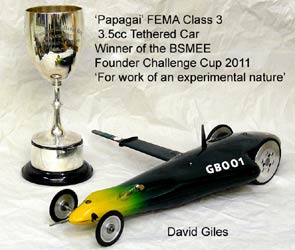
YouTube video clip European
2009
Championships
Orebro Sweden
YouTube video clip of the
Basel Switzerland track
Photobucket albums of Kapfenhardt from
Ken Croft
Note! For reasons of expediency, a number of notable engineers and personalities have been omitted from this narrative. I trust that the subject has been covered adequately and concisely and will not cause offence to anyone overlooked.
Sources of Information:-
Model Car News; Model Engineer; Model Maker; Aeromodeller Annual; The Classic
Motorcycle; 25 Jahre Deutsche Modell Motor Club – Festschrift; Joy in the Making
– 100 years of the Sydney Society of Model Engineers; IFA/MZ Renngeschichte 1949
– 1961 by Manfred Woll, published by Heel Verlag; Rail and Cable News – reprint
by K&G Enterprises; Motorrad Museum Augustusburg – museum guide; Les Motors
Modèles Réduits Français by Claude Dhekaier, Serge Holc & Michel Molinié; Mr.
Lembit Vaher – Eesti Automudelispordi Klubi.
|
|
Based on the transcript of a talk given by David Giles |
|
Additional photos courtesy of Ken Croft,
Mark Mansell, John Goodall, Terry
Everitt, Olly Monk, Edvard Stelling, Stuart Robinson,
Ken Smith and
Ron Reiter
©copyrightDavidGiles2012